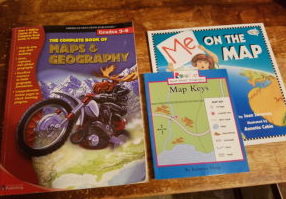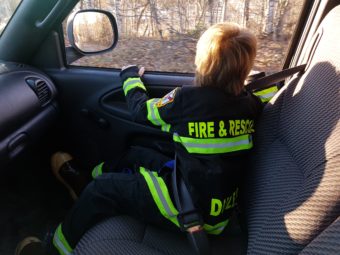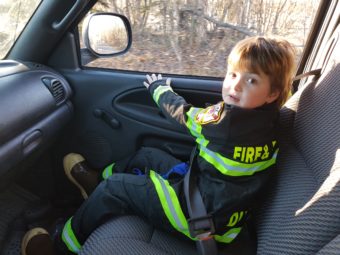The goals of this unit are pretty straight forward. First it’s to better understand exactly what happens when a person calls 911, and how it leads to dispatching particular units and apparatus. Next it involves the practice of using walkie-talkies (an interesting skill to share the modern child!), and finally the inclusion of map skills and better understanding the lay-out of your own community.
Similar to the last unit, the skills being learned here are obviously important for a future firefighter, but imagine what life value they contain when it comes to a real emergency between now and then! Your child may be the one to call in an emergency and location, saving someone’s life!
The official list of resources for this unit is rather short, but it can take some time to coordinate getting the various activities accomplished.
The resources and activities we used for Unit 3:
(These and other helpful resources are discussed in more detail on the Orientation Page, while the begging of the year Homeschool Plans page outlines (with links as we go along) each of the units we will cover.)
- Communications Center and Dispatch:
- Fundamentals of Fire Fighting Skills (third edition) (FFS)
- Various parts of pages 92-93, 96, 97, 98, and 99-100
- YouTube Videos
- Dispatch Center Tours
- Real Life 911 Calls (Pre-view these for your child.)
- Fundamentals of Fire Fighting Skills (third edition) (FFS)
- Using a Radio:
- Fundamentals of Fire Fighting Skills (third edition)
- Various parts of pages 106-111
- Fundamentals of Fire Fighting Skills (third edition)
- Map Skills:
- Age appropriate Non-Fiction resources and/or social studies map workbooks (check school supply stores and your local library)
- REVIEW: Barron’s Firefighter Exams: 6th Edition:
- Pages 452, 168-71, 315-16, 460-1, and a particularly tough one 336-38
- Hands-On and Field Trips:
- Visit the Dispatch Center or Speak with a Dispatcher
- Practice taking a 911 call (FFS Page 99-100, and 111; skill drill 4-5)
- Practice using radio (FFS Page 108-9; skill drill 4-3)
- Use a map to:
- Find parts of your local area
- Pin-point your exact location when traveling around town.
- Practice ‘Prioritizing and Classifying’ incidents with mock situations:
- discussion only
- hands-on
So how did it go for us?!
We have ended up having to put our field trip to the dispatch center on hold for a couple months to better coordinate with a High School friend of mine who is now a dispatcher. It will still be great in that the field trip will still totally be relevant long after we moved on from the unit, and, in-fact, it will probably be even better as a review for what we’ve learned. I will be sure to insert it here as an edit when we finally do get together with her and visit the dispatch center.
*****MORE PHOTOS AND GOODIES TO COME****

A couple examples of non-fiction reading and workbooks for elementary map skills
Nathan really liked our ‘map skills’ mock emergency drives around the neighborhood. I printed enlarged maps of our streets off Google and taped them together. I would then ‘call-in’ an emergency (from the seat next to him) and have him give me “one block north” and “take a left on _____” type directions. It was great for discussing why they make fire stations in certain locations and what it means to the speed of response when an engine has to travel from a false alarm farther across the neighborhood to a real one. At times I stop and randomly ask him what street we are on, and we look for house and building numbers when we are out. We talked about even and odd house numbers being on separate sides of the street, and that a plot of land with no house still has it’s own numbers; it’s just waiting to be developed.


For walkie-talkie play we have gone to other ends of the house/property to call in mock emergencies. I even took one to the store in-order to communicate from way out of ear shot. I once put a walkie-talkie on our baby rescue cadaver to make it sound like they were crying in the back of a blacked-out room for blind rescue practice.
We are continuing to add pages to Nathan’s Firefighter Skills book, with a list of the steps involved in taking a an emergency call, leading up to the actual dispatch, (FFS page 96), along with whatever drawings he would like to add.
Then the last part of the unit, doing some basic classifying, prioritizing, and triage, was introduced and we will certainly continue building on this as both the First Responder Skills and the Firefighter Skills units progress. For now we talk about some basic and obvious injuries. Soon enough I will make the scenarios more detailed. As odd as it may sound, prioritizing people’s injuries is rather fun.
….but maybe it’s just my compulsive sorting nature kicking in.
A short video showing Nathan learn some triage skills while trying to get our CF stuff done, too. “Cry Baby Itchy Man!” :


Post a comment